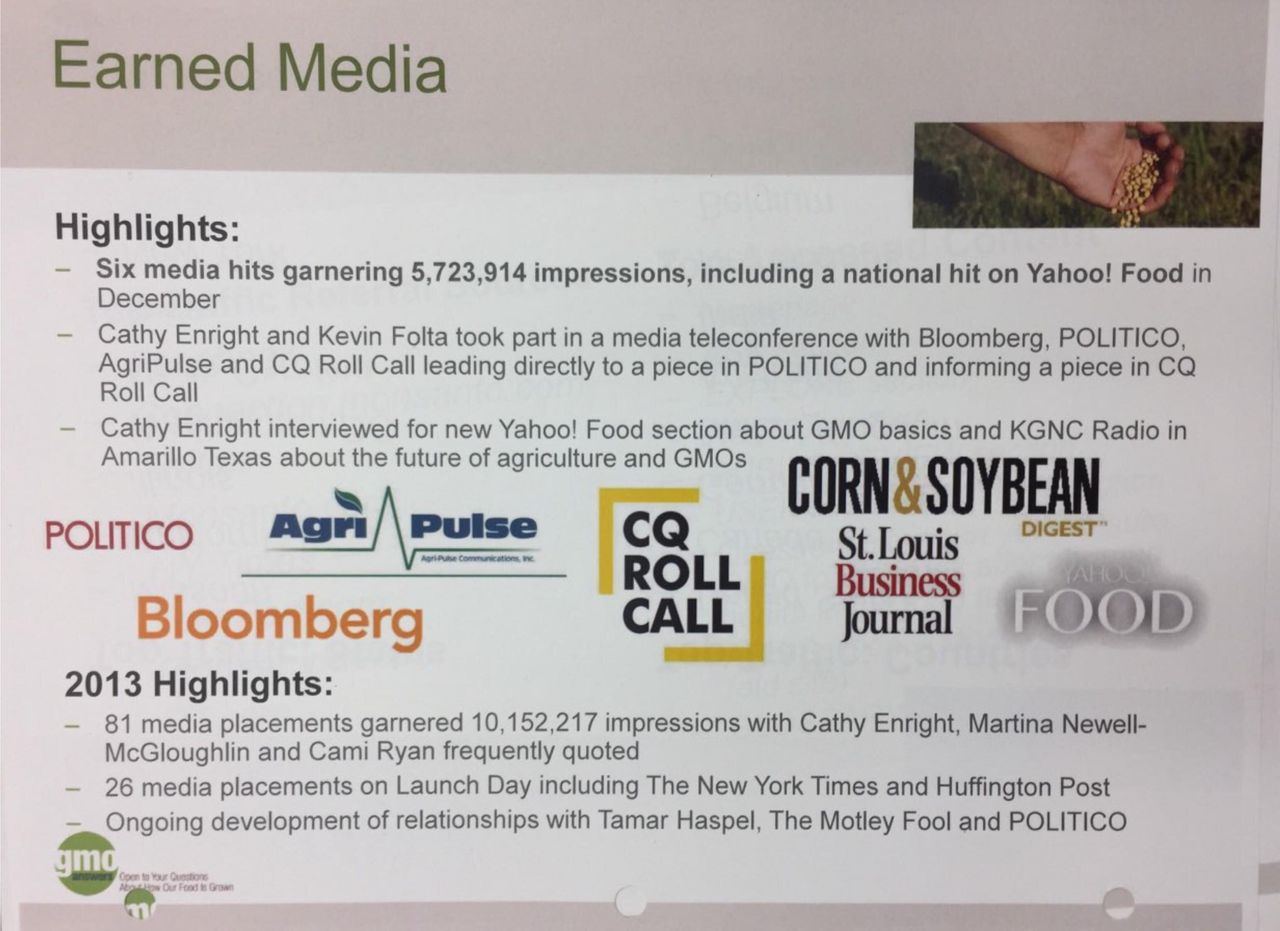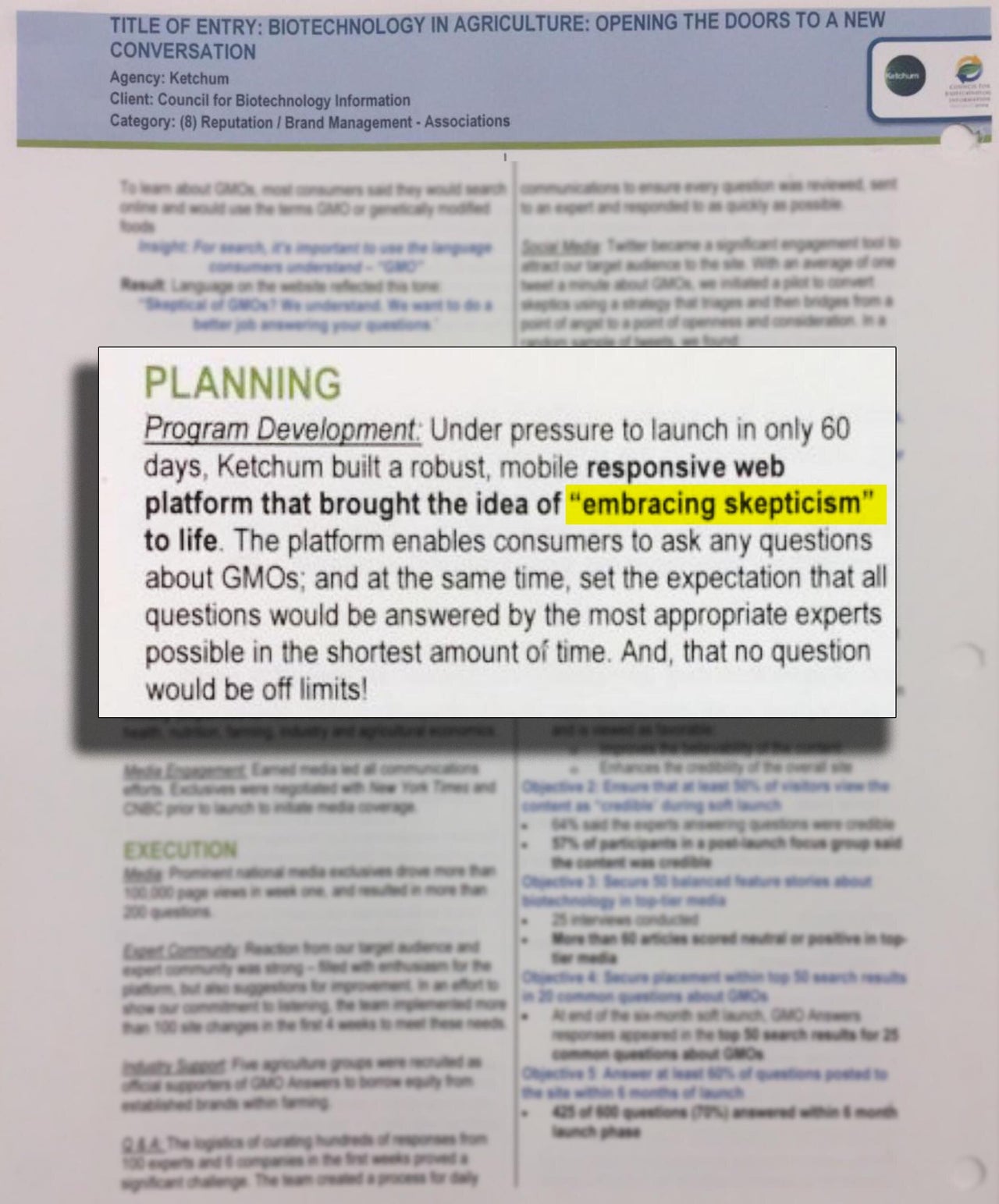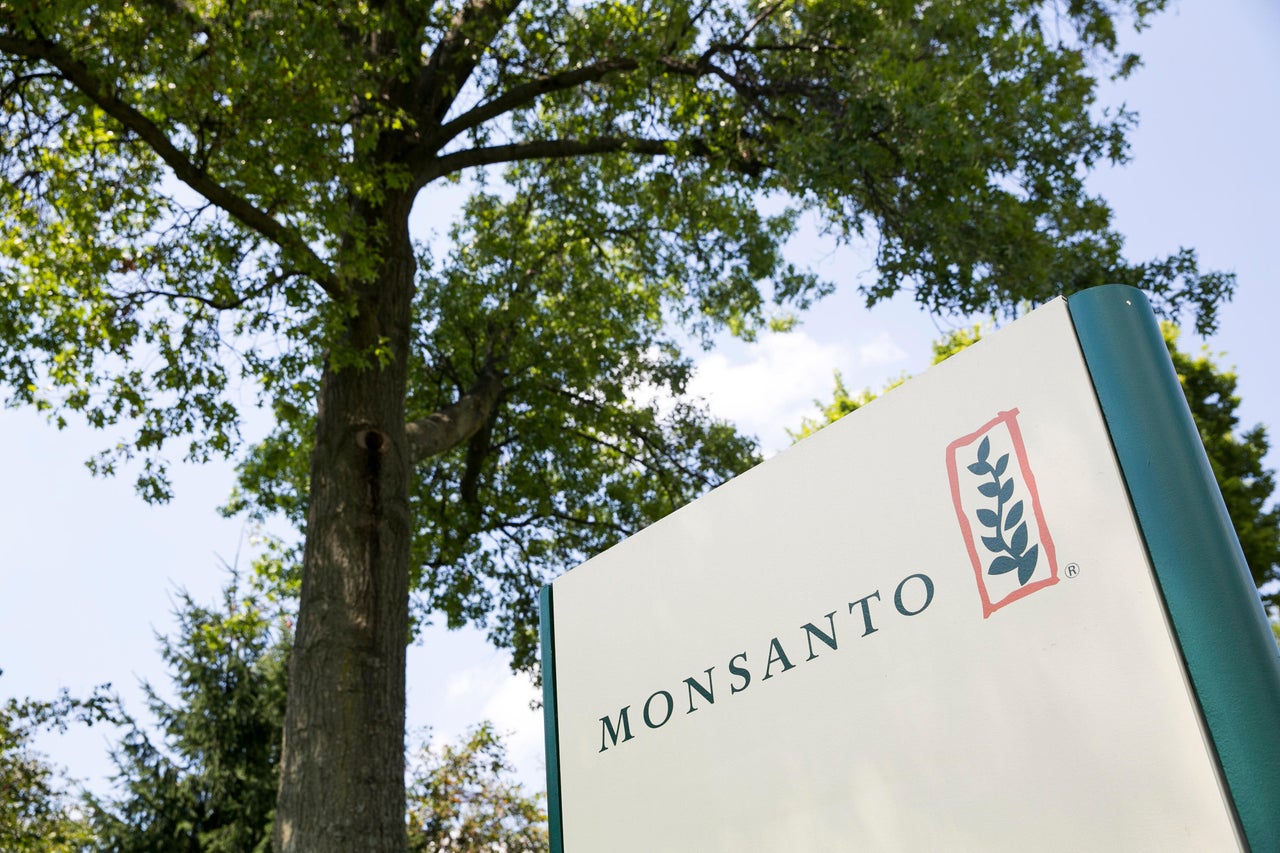Agricultural giant Monsanto has spent much of the last decade attempting to polish its public image amid campaigns to label genetically modified organisms (GMOs) and horrifying stories about how the company treats anyone who might get in its way.
In 2013, it enlisted Ketchum PR ― the public relations firm for Russian President Vladimir Putin, Russian natural gas giant Gazprom and many governments known for human rights abuses ― to help. To reboot the national dialogue, Ketchum created a campaign called GMO Answers, and used social media and third-party scientists to offer a counternarrative to allay concern about Monsanto’s products. HuffPost has acquired 130 pages of internal documents from an anonymous source that detail the campaign and its tactics for enhancing Monsanto’s public image ― tactics that include developing close relationships with one writer in particular that seem to have paid off for the company. (Bayer bought Monsanto in 2018.)
At the time Ketchum launched GMO Answers, Tamar Haspel was a blogger and health writer who had written several pieces supportive of the GMO industry on HuffPost and other sites. Haspel posted a piece enthusiastically promoting the new campaign and was one of the first people to submit a question to the GMO Answers website.

Later that year, Haspel, an oyster farmer living on Massachusetts’ Cape Cod, got a new gig writing a food column for The Washington Post. In her column, she has regularly promoted genetically modified foods and downplayed the dangers of chemicals, even quoting from Ketchum and the third-party scientists that agrichemical companies promote to offer a contrary take. Those companies have in turn amplified Haspel’s work and raised her profile.
Behind the scenes, Ketchum’s documents show a reporter eager to collaborate with the firm and promote its new campaign ― and Ketchum happy to foster that relationship. (This reporter has donated the 130 pages of Ketchum material to the Industry Documents Library at the University of California, San Francisco.) Another page discusses GMO Answers’ “earned media” and a plan for “ongoing development of relationships” with Haspel — the only media person mentioned by name — as well as outlets The Motley Fool and Politico.
For many who have been suspicious of Haspel’s relationship with agrichemical giants, the documents are further evidence that she’s too close to the industry she writes about and that her prominent column at The Washington Post provides a perch to spread misleading information about agriculture and the food we eat. At the very least, they offer a behind-the-scenes look at how public relations specialists work to shape public perception through their interactions with journalists.
“Tamar tries to sell herself as this simple oyster farmer, but she clearly leans toward industry,” said Michael Hansen, a senior staff scientist at Consumer Reports. “She uses science as a cudgel: ‘Science says X, and anyone who says differently is not being scientific.’”

An Emerging Pattern
Haspel began her Post columns in October 2013, promising to “negotiate the schism and nail down the hard, cold facts” about GMOs. These columns have been sympathetic to the agrichemical industry, promoting GMO products and commodity crops, downplaying the dangers of toxic substances and pesticides, and finding fault with organic agriculture.
Among them, a column cites the potential of genetically modified mosquitoes to help control dengue fever and GMO cows that could slow the spread of African sleeping sickness. In both examples, there’s no clear evidence that they work — the GMO cow never even seems to have been engineered — but Haspel projects their benefits as scientific fact.
Haspel tried to downplay the dangers of glyphosate — the pesticide that many GMO crops have been designed to tolerate and that the International Agency for Research on Cancer has said is a probable human carcinogen — in an October 2015 column. However, she did not disclose that one of her sources, Keith Solomon, was a consultant for Monsanto who had previously been criticized for his work defending another crop science giant, Syngenta, on the pesticide atrazine. After Haspel’s column, Solomon was later accused of having Monsanto ghostwrite studies for him and other scientists on glyphosate.
Meanwhile, internal emails show an increasingly friendly relationship between Haspel and Monsanto’s representatives and third-party scientists. In a 2015 email to University of Florida professor Kevin Folta, Haspel wrote that she just promoted a talk by him on Twitter and relayed an anecdote about a panel on science communication: “One of my panelists was from Monsanto (Janice Person), and when I asked the audience what was the last issue on which you changed your mind, one of them said, ‘I think I just changed my mind about Monsanto.’”
“It’s possible to make some headway,” Haspel noted, “but I’m convinced it’s by person-to-person interaction.”

At the time, Folta was putting together one of multiple industry-funded events he has helped organize to discuss GMOs and the pesticide glyphosate. Haspel was one of his favorite speakers, and he emailed her a schedule, to which Haspel responded, expressing excitement about meeting one of the attendees, Monsanto spokesperson Vance Crowe.
“Very much looking forward to this,” Haspel wrote. “I’ve wanted to meet Vance Crowe ― very glad he’ll be there.”
A few months after the conference, The New York Times exposed Folta in a Sept. 5, 2015, front-page story for hiding his financial ties to Monsanto and becoming part of the company’s lobbying campaign. Haspel later emailed a bizarre apology to Folta: “I am very sorry for what you’ve gone through, and it’s distressing when mean-spirited, partisan attacks overshadow the real issues — both on the science and on the transparency, both of which are so important.”
When Ketchum partnered with Scientific American in 2016 to host discussions on science communications, HuffPost reported that Haspel was one of the three journalists chosen to speak on a panel.
A January 2016 Haspel column cites Ketchum’s research to suggest that the food movement — a developing concept that essentially argues activists and young foodies are seeking healthier, locally, and more responsibly grown food — isn’t much of a movement at all and that most people aren’t overly concerned about GMOs and pesticides. Rep. Chellie Pingree (D-Maine), who runs an organic farm, co-wrote a rebuttal with Anna Lappe, a best-selling food author and co-founder of the Small Planet Institute.
Lappe said they wrote the rebuttal not just because Haspel’s writing on organic agriculture is often “ridiculous” and “wrong,” but because the journalist misconstrued the Ketchum study itself. In fact, PR Week reached the opposite conclusion from Haspel’s, deeming the study as evidence that food evangelists could no longer be considered a small group, as their numbers had increased by 10% in just two years.
Haspel shot back at her critics in a later interview: “If you want to know what consumers really think and care about, a firm like Ketchum is who you want to hear from, because they live and die by getting it right. I repeatedly asked, ‘Do you have any data that contradicts it?’ In all the controversy, I didn’t see any contradictory data.”
Haspel did not respond to several questions, but she sent a statement saying she lists her speaking gigs and has written columns critical of the industry. (Her policy on this is posted on her personal website, as is a list of past speaking engagements.) She noted that the author of this piece has sent tweets critical of her writing and stated, “I’m perfectly happy to have readers infer my views from my writing and public comment; but it has to be the whole body of my work.”
“The problem isn’t just about Tamar Haspel,” Lappe said, “but she is a symptom of a broader problem: the lack of robust journalism as industry front groups shape public narratives.”

‘Embracing Skepticism’
Pages of Ketchum PR documents that discuss Haspel are labeled, “Success! A Strategy That Embraces Skepticism.” For Monsanto, any story that muddies the water on the science critical of its products is a win, and Haspel’s have been arguably the most prominent in national media. The company’s touting of those articles is part of a mutually beneficial loop — she promotes its science; it promotes her on industry sites and social media.
A quote from Haspel also appears atop the website for Sense About Science, a nonprofit that purports to deliver unbiased, transparent science to reporters but which has been cited for its own links to industry.
“Embracing skepticism” is a strategy the PR firm of Hill & Knowlton created for tobacco companies in the 1950s, a way to counter the prevailing science on a subject with experts who would offer a more industry-friendly alternative. Harvard historian Allan Brandt described the scheme as “brilliant” — it allowed tobacco companies to pretend they were addressing the accumulating evidence that cigarettes caused cancer while effectively undermining the public’s confidence in that evidence.
“It’s an incredibly effective corporate strategy: Set up your own science and then shape and influence discussion,” he said. “These are the building blocks and foundation of current debates on health science and conflicts of interest.”

It’s a strategy Monsanto has clearly employed. Court documents exposed how the company ghostwrote studies for academics that argued for the safety of the pesticide glyphosate, and the company worked behind the scenes with friendly scientists to orchestrate the retraction of a study that found fault with glyphosate and GMO corn.
Another tobacco-created tactic Monsanto deploys is using seemingly independent scientists and nonprofits to act as its emissaries to the press. Among the company’s go-tos are Nina Federoff, an emeritus professor of biology at Penn State and science adviser to a law firm that represents the biotech industry. Federoff has appeared at several of the industry-sponsored events Haspel has participated in and works closely with industry. She also promotes the American Council on Science and Health, a front group Monsanto has paid to attack reporters and scientists critical of industry’s financial influence on science.
There’s also Jon Entine, who runs the Genetic Literacy Project, a website owned by a PR firm whose former clients include Monsanto. In one lawsuit, a plaintiff’s lawyers told a judge that Monsanto funnels money to the Genetic Literacy Project and the American Council on Science and Health in order to “shame scientists and highlight information helpful to Monsanto and other chemical producers.” Haspel was among the “faculty” at an event the Genetic Literacy Project co-organized on food and biotech, with University of Illinois professor Bruce Chassy, a consultant for Monsanto. Chassy emailed several potential invitees that speakers were offered “as much as $2500 (journalists aren’t inexpensive).”
Haspel has also faced criticism over the years for her attendance at industry junkets — trips where industry organizations pay reporters’ expenses and sometimes offer speaking fees — such as those of the North Carolina Biotechnology Center, Center for Food Integrity and International Service for the Acquisition of Agri-Biotech Operations. This raised alarms among watchdogs.
In a 2015 Washington Post live chat, Haspel explained, “I speak and moderate panels and debates often, and it’s work I’m paid for.” In the same chat, she dismissed a critic for being biased by “ideology,” warning that it “can warp perception just as reliably as money can.” The Genetic Literacy Project then amplified Haspel’s viewpoint.
Brandt notes that when reporters and experts start following the money to root out corporate financial influence in science, a common tactic is to then accuse those people of being biased by ideology or lack of objectivity. “It’s right out of tobacco’s playbook. If you say they are paid for by industry, they will call you an advocate. In some ways, it’s about creating this false equivalence.”
To tamp down criticism, Haspel began disclosing her speaking gigs on her personal website and wrote a piece for the National Press Foundation on ethics for freelance writers. But the National Press Foundation has also faced its own ethical concerns for collaborating with corporations such as Monsanto, the drug company Bayer and other pharmaceutical companies. A recent British Medical Journal investigation by this reporter exposed its work with Coca-Cola on journalism junkets that distracted reporters from the negative health effects of soda.
“This is definitely a new kind of journalism,” said investigative reporter James B. Steele, who has written articles about Monsanto. Haspel’s junkets remind him of the problems in travel writing, where many of the reporters unethically take handouts from hotels, restaurants and cruise ships and then write about the products.
“My guess is that the top editors at the Post don’t realize this is happening in the food section,” he said.
HuffPost sought comment on the documents from Carla Broyle, the Post’s senior editor for recruiting and training, who did not respond. The Post’s director of communications, Shani George, responded instead: “We see value in having Post subject matter experts explain the role of journalism and the work they do to different audiences and aim to avoid conflicts of interest or the appearance of a conflict of interest wherever and whenever possible. As our policy states, journalists should avoid accepting payments from organizations that try to influence issues they cover.”
Who Gets The Benefit Of The Doubt?
In other areas that benefit commodity crops (such as corn, potatoes and other items sold to large companies), Haspel often wades into controversies in ways that always seem to give the benefit of the doubt to big food companies ― while getting the science wrong.
In January 2017, Haspel quoted Walter Willett, a professor of epidemiology and nutrition at Harvard, in a column downplaying the potential health problems from excessive consumption of potatoes. Willett’s findings conclude that small amounts of potatoes in your diet are not bad, but people would be better off getting most of their starch calories from whole grains. Other prominent research also finds benefits from whole grains, such as reducing risks for cardiovascular disease and diabetes.
Others quoted in the piece have not published data on potatoes like Willett, but were given greater weight in Haspel’s conclusions about the nutritional value of the tuber.
“Tamar tries to set herself up as the ultimate authority,” Willett said. After the column ran, he sent Haspel a note along with a copy of his book “Nutritional Epidemiology,” which is the standard textbook in the field. “I said, ‘As long as you’re going to be writing about nutrition, it would be good for you to learn a bit.’”
Last summer, when the American Academy of Pediatrics issued a warning that chemicals in food colorings, preservatives and packaging can be dangerous to children and they aren’t being suitably regulated, Haspel offered up a column downplaying those concerns. It quoted Alan Levinovitz, a professor of religion, as an expert.
Dr. Leo Trasande, vice chair for research in the department of pediatrics at the New York University School of Medicine and author of “Sicker, Fatter, Poorer,” said the Haspel column “distracts from the scientifically documented concerns with synthetic chemicals found in food, such as phthalates, bisphenols, perfluoroalkyl substances, and perchlorate.”
This June, Haspel published a column on artificial sweeteners that caught the attention of Marit Zinocker, a nutritional biologist at Bjorknes University College, in Oslo, Norway, who studies the gut microbiome. Zinocker began tweeting questions at Haspel, asking her to explain her odd column making “the case for diet soda,” which downplayed nutritionists’ concerns and argued that “the research” actually indicates there is little evidence it’s bad for us.
Haspel responded on Twitter by dismissing much of the epidemiological studies on the topic as well as research using mice.
“She has so many followers and what she writes will be the truth,” said Zinocker, “and so when I know what she writes is not the truth, I have to go after it, even though it might not have any impact.”
Other scientists who study the issue noticed as well, including Susan Swithers, a professor at Purdue University who studies artificial sweeteners. “Diabetes and cardiovascular disease have been linked to regular consumption of diet soda over decades,” Swithers said.
A 2013 review of potential biological problems caused by sucralose noted the compound can reduce beneficial gut bacteria and negatively affect blood glucose and insulin. The German government recently advised citizens to not heat food containing sucralose, as the compound can form chlorinated compounds at higher temperatures that can cause cancer. None of that info was in Haspel’s column.
Brandt wonders if journalists still haven’t learned the lessons of the tobacco era.
“A lot of journalists don’t want to ask hard questions because they need access to sources that they don’t want to irritate,” he said. So too do journalists feel a need to create “balance” by quoting both sides in their stories — even when one side has clear reasons to promote the science most beneficial to its product.
“Science journalists can often become the vehicle for getting out an industry message,” he said.
Clarification: Language has been amended to characterize more accurately the industry-funded events that Folta has helped to organize, and to include additional links to Haspel’s speaking gigs and conflicts of interest policy.
